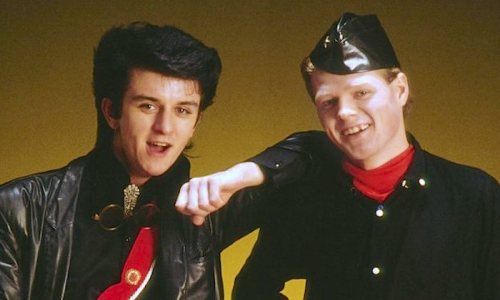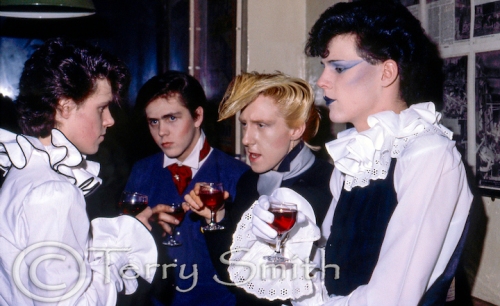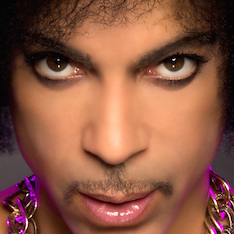INDEX OF ALL 800+ POSTS
➢ 2009 till now : Click to list everything at Shapers of the 80s.
Now in our fifteenth year.
Thanks for 2.2 million hits.
ON YOUR MOBILE
➢ Choose “View full site” – then in the blue bar atop your mobile page, click the three horizontal lines linking to many blue themed pages with background articles.MORE INTERESTING THAN MOST PEOPLE’S FANTASIES — THE SWINGING EIGHTIES 1978-1984
They didn’t call themselves New Romantics, or the Blitz Kids – but other people did.

“I’d find people at the Blitz who were possible only in my imagination. But they were real” — Stephen Jones, hatmaker, 1983. (Illustration courtesy Iain R Webb, 1983)
“The truth about those Blitz club people was more interesting than most people’s fantasies” — Steve Dagger, pop group manager, 1983PRAISE INDEED!
“See David Johnson’s fabulously detailed website Shapers of the 80s to which I am hugely indebted” – Political historian Dominic Sandbrook, in his book Who Dares Wins, 2019
“The (velvet) goldmine that is Shapers of the 80s” – Verdict of Chris O’Leary, respected author and blogger who analyses Bowie song by song at Pushing Ahead of the Dame
“The rather brilliant Shapers of the 80s website” – Dylan Jones in his Sweet Dreams paperback, 2021
A UNIQUE HISTORY
➢ WELCOME to the Swinging 80s
➢ THE BLOG POSTS on this front page report topical updates
➢ ROLL OVER THE MENU at page top to go deeper into the past
➢ FOR NEWS & MONTH BY MONTH SEARCH scroll down this sidebar
❏ Header artwork by Kat Starchild shows Blitz Kids Darla Jane Gilroy, Elise Brazier, Judi Frankland and Steve Strange, with David Bowie at centre in his 1980 video for Ashes to AshesVINCENT ON AIR 2024

✱ Deejay legend Robbie Vincent has returned to JazzFM on Sundays 1-3pm… Catch Robbie’s JazzFM August Bank Holiday 2020 session thanks to AhhhhhSoul with four hours of “nothing but essential rhythms of soul, jazz and funk”.TOLD FOR THE FIRST TIME
◆ Who was who in Spandau’s break-out year of 1980? The Invisible Hand of Shapersofthe80s draws a selective timeline for The unprecedented rise and rise of Spandau Ballet –– Turn to our inside page
-
RECENT ADDITIONS
- 2024 ➤ Ahaaaah! 25-year-old stage musical Mamma Mia! confirms ABBA’s genius
- 2024 ➤ London’s Evening Standard publishes my obituary of Linard the wild child of UK fashion
- 2024 ➤ Farewell to Linard, the craziest man I’ve known
- 2024 ➤ Pilger’s fearlessness is what journalism still needs today
- 1992 ➤ Who’s the keenest fan of Marcel Proust?
- 2023 ➤ Johnny Marr climaxes his solo career with stunning book and unique live concert
- 1963 ➤ Where were The Beatles the day Kennedy was shot?
- 2023 ➤ Young sculptor brings bronze into the age of 3D printing
- 2023 ➤ Witnessing the performance of Gambon’s life as his tribute to Pinter
- 2023 ➤ One savvy fan rates Kid Creole’s London extravaganza
- 2023 ➤ Kid Creole returns to Britain with that vintage Darnell bazzazz
- 2023 ➤ Linard snapped in the footsteps of Duchamp
SEARCH our 800 posts or ZOOM DOWN TO THE ARCHIVE INDEX
UNTOLD BLITZ STORIES

✱ If you thought there was no more to know about the birth of Blitz culture in 1980 then get your hands on a sensational book by an obsessive music fan called David Barrat. It is gripping, original and epic – a spooky tale of coincidence and parallel lives as mind-tingling as a Sherlock Holmes yarn. Titled both New Romantics Who Never Were and The Untold Story of Spandau Ballet! Sample this initial taster here at Shapers of the 80sCHEWING THE FAT
LANDMARK FAREWELLS. . . HIT THE INDEX TAB UP TOP FOR EVERYTHING ELSE
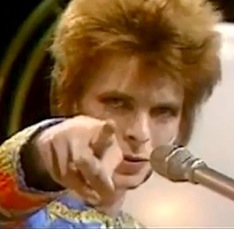
➢ Search for all on Bowie here
at Shapers of the 80s✱ “I’m not a rock star” Bowie often said – No, David, you were a messiah – Obituaries and key videos on the godlike one
✱ Prince Rogers Nelson RIP: ‘A funny cat’ and ‘sole authentic genius’ of the 1980s
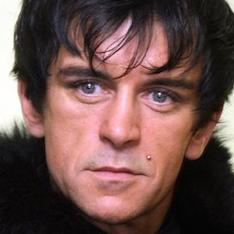
✱ 2015 – Original Blitz Kids say farewell to Steve Strange – read exclusive tributes to the King of the PosersArchive — Many publication dates are arbitrary, so click and take pot luck!
RANDOM!
Tag Archives: Kim Bowen
➤ Four years on: How the Blitz Kids paid magnificent tribute to Steve Strange
On the fourth anniversary of Steve Strange’s passing
(not to mention the 40th anniversary of his Tuesday club-night
opening at the Blitz), how better to remember the man who revolutionised London nightclubbing than with the massive collection of tributes assembled here at Shapers of the 80s
from every significant Blitz Kid the day after Steve died…
Brief tasters. . .
Original Blitz Club deejay Rusty Egan said: “I’m very, very sad and down tonight because I’ve lost an old friend. We had our disagreements but we did have a decade of the best times that anybody could ever have wished for. We made some amazing music, some amazing parties, clubs and fun and friends. Underneath it all he was a good soul. Steve, I’m so sorry I didn’t get a chance to say I still love you.”
Chris Sullivan, who ran Soho’s Wag Club: “We were both flamboyant club-running Welsh dandies but were never rivals. Steve had too much dignity for that. We were friends and remained so for the rest of his life. And I can say that Steve, despite quite a few hard years, never lost that that spark, humour or joie de vivre, was forever stylish and was always a pleasure to see.”
Princess Julia, writer and deejay: “Getting dressed up, going out and getting noticed… Steve was head of a subculture the likes of which perhaps we will never see again.”
Kim Bowen, stylist, onetime Queen of The Blitz: “Rushing enthusiasm, involving everyone, creating insane parties going round and round on the Circle Line. Some truly bad outfits (his not mine.) Shockingly, ‘Kim, will you be my official girlfriend?’ ”
And many, many more delicious anecdotes…
Posted in Britain, Clubbing, Fashion, History, interviews, London, New Romantics, nightlife, obituaries, Pop music, Swinging 80s, Tipping points, Tributes, videos, Youth culture, zeitgeist
Tagged Blitz Kids, Chris Sullivan, Kim Bowen, New Romantics, Princess Julia, Rusty Egan, Stephen Harrington, Steve Strange, Visage
➤ Day Two of Terry Smith’s unseen photos inside the Blitz Club, exclusively at Shapers of the 80s
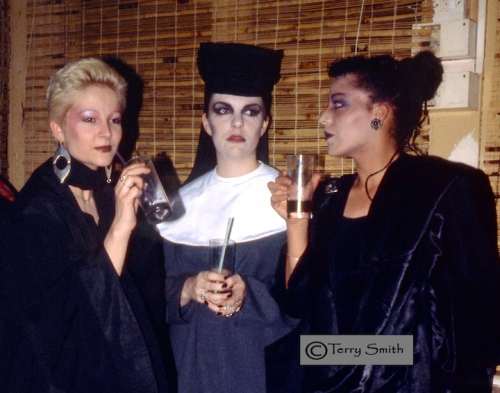
“Double, double, toil and trouble” . . . Mandy d’Wit, Judith Frankland and Darla-Jane Gilroy await the casting call in case Mr Bowie drops in at the Blitz
➢ DAY TWO:
CLICK HERE TO VISIT OUR
GALLERY OF TEN MORE FAB IMAGES
OF THE BLITZ IN COLOUR
◼ A SURPRISING NEW CACHE of photographs of the Blitz Club in colour has been discovered from the spring of 1980 when TIME magazine asked British photographer Terry Smith to turn his lens on the nightlife posers at Covent Garden’s Blitz Club. They were to become feted as the New Romantics.
Tuesdays at the Blitz were all ritual. Everyone supped and danced on the same spot every week according to some invisible floorplan: downstairs near the bar stood the boys in the band (no make-up), their media and management by the stairs, credible punk legends such as Siouxsie Sioux along the bar, suburban wannabes beside the dancefloor.
Deep within the club, around Rusty Egan’s deejay booth, were the dedicated dancing feet, the white-faced shock troops, the fashionista elite – either there or near the cloakroom, ruled first by Julia Fodor (still going strong as deejay Princess Julia) and later by George O’Dowd (known today as ex-jailbird Boy George). Downstairs, the women’s loo was hijacked, naturally, by boys who would be girls. Upstairs on the railway banquettes might be respected alumni from an earlier London: film-maker Derek Jarman, artists Brian Clarke and Kevin Whitney, designers Antony Price and Zandra Rhodes…
➢ Previously at Shapers of the 80s:
1980, Just don’t call us New Romantics
Posted in Britain, Clubbing, dance music, Fashion, London, New Romantics, photography, Pop music, Swinging 80s, Tipping points, Youth culture
Tagged Chris Sullivan, Darla-Jane Gilroy, David Holah, Dick Breslaw, Fiona Dealey, George O’Dowd, Harley Price, Helen Carey, Jeremy Healy, Judith Frankland, Ken Banta, Kim Bowen, Lesley Chilkes, Lucy Bell, Mandy d’Wit, Philip Sallon, Rose Turner, Rusty Egan, Stephen Jones, Steve Strange, Terry Smith, Time magazine, Tracey Rivers
1980 ➤ Unseen photos inside the Blitz Club, exclusively at Shapers of the 80s

Never before published: Steve Strange, co-founder with deejay Rusty Egan of the legendary Tuesday night at the Blitz in London
➢ DAY ONE:
CLICK HERE TO VISIT OUR
GALLERY OF TEN FAB IMAGES
OF THE BLITZ IN COLOUR
◼ AN ENORMOUS NEW CACHE of photographs of the Blitz Club in colour has been discovered from the spring of 1980 when the UK media started to take an interest in the Tuesday-night antics of the nightlife posers at Covent Garden’s Blitz Club. They were to become celebrated as the Blitz Kids by some and as New Romantics by others. Until this moment it has been easy to count the number of surviving professional pictures ever taken inside the Blitz during its 20-month life – all of them in black-and-white – and the total doesn’t even approach 100.
Now a call to Shapers of the 80s by the British photographer Terry Smith has unearthed probably 300 more images, commissioned by Time magazine. Many of them are in glorious colour, shedding extra light on the creativity of the night-owls who were in the throes of transforming the fashion and pop landscape of Britain in the Swinging 80s.
Shapers of the 80s today showcases the first of four batches of Terry’s pictures capturing the Blitz in colour, while a selling exhibition of his black-and-white images is preparing to open on 7 June in St Leonards-on-Sea.
Posted in Clubbing, exhibitions, Fashion, History, journalism, London, Media, New Romantics, nightlife, photography, Pop music, Swinging 80s, Tipping points, Youth culture
Tagged David Holah, Fiona Dealey, George O’Dowd, Harley Price, Jeremy Healy, Judith Frankland, Ken Banta, Kim Bowen, Lesley Chilkes, Lucy Bell, Philip Sallon, Rose Turner, Rusty Egan, Stephen Jones, Steve Strange, Terry Smith, Time magazine, Tracey Rivers

